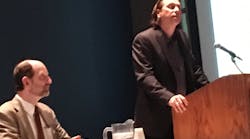In the Lightfair seminar, “Best Practices for Tunable Light Specification,” Adam Carangi, specification director, Lumenetix, and Charles Knuffke, Wattstopper/Legrand, gave lighting specifiers and designers some ideas of how to engineer lighting systems utilizing tunable light.
Carangi, a 20-year lighting veteran who has worked as a lighting rep and manufacturer, joked that when the Philips Hue LED system came out, lots of people thought they were lighting designers because they figured out how to use the Hue app to develop multiple color scenes.
As Carangi and Knuffke, system vice president/evangelist for Wattstopper, told attendees, working with tunable light is not quite that easy. Engineers and designers have to work very carefully to properly pair LEDs with controls, they said.
Carangi and Knuffke told attendees some of the most common applications for tunable light are in hospitals and schools. In hospitals, designers tune the light differently for patient rooms and nurses’ work stations, while in schools they may tune the light to change according to the time of day or class schedule, so they can maximize students' focus on tasks.
Carangi offered some interesting tips to the audience on how to make note of tunable lighting fixtures in their designs, particularly in their fixture schedules and in any documentation on how the lighting system should be commissioned or operated.



